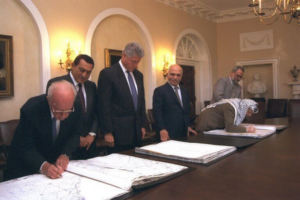Oslo after thirty: A paradigm beyond partition

Israeli PM Yitzhak Rabin (L) and PLO Chairman Yasser Arafat (R) sign Oslo 2 maps in the White House as (L-R) Egyptian President Husni Mubarak, US President Bill Clinton and King Hussein of Jordan watch, 28 September 1995
In Mondoweiss, the Arab Renaissance for Democracy and Development (ARDD) Senior Advisor on the Question of Palestine, Dr. Lex Takkenberg, reflects on the plight of the Palestinian people, who have been deprived of their homeland in the century-old confrontation with Zionism and Israel, three decades after the conclusion of the Oslo Accords. Building on British and UN propositions in the 1930s and 40s, Oslo represented the latest effort by the international community at the territorial partition of historic Palestine into a Jewish and Palestinian state. Thirty years later, it has become clear that the ‘logic of partition’ has failed and that the evolving one-state apartheid reality to which Palestinians have been subjected calls for a fundamental reset. A new political ‘grammar’ is emerging around a new – or old, from a Palestinian perspective – paradigm, moving beyond partition and separation towards a democratic one-state solution. Takkenberg explores the drivers of the new discourse as well as its ramifications and implications for the principal stakeholders.
On September 13, 1993, PLO Chairman, Yasser Arafat, and Israeli Prime Minister, Yitzhak Rabin, signed the Declaration of Principles on Interim Self-Government Arrangements — commonly referred to as the (first) Oslo Accord — on the White House Lawn in the presence of then-U.S. President, Bill Clinton, and invited dignitaries. Thirty years later, commentators laud the success of Israel in the Oslo Accords, including several subsequent agreements. Commentators offering a Palestinian perspective relate to the agreements’ betrayal of the Palestinians, meant only to help Israel consolidate its occupation and colonization. The Oslo framework allowed Israel’s extended and enhanced control over the Gaza Strip and the West Bank, including East Jerusalem, and its Palestinian inhabitants, eventually culminating in what is increasingly and authoritatively recognized as a one-state apartheid reality.
The Oslo Framework — the accords and the Middle East Peace Process that accompanied them — reiterated the idea of territorial partition, recommended first by the United Kingdom in 1937 when it held the Mandate over Palestine, and subsequently by the UN General Assembly in its 1947 Partition Plan. The “logic of partition” and the “statist” interpretation of the right to national self-determination — according to which partitioning the land between Jews and Palestinians in two separate states was deemed the most desired and effective way to meet the demands of the conflicting parties — have dominated the hitherto unsuccessful attempts to settle the Question of Palestine.
On the positive side, the past three decades have witnessed a dramatic increase in efforts towards Palestinian justice and holding Israel to account for its crimes against the Palestinians, despite the official Palestinian leadership being held hostage by the Oslo trap. Palestinians have adopted a clear, predominantly non-violent strategy towards liberation, primarily through the Boycott, Divestment, and Sanctions (BDS) movement and sustained efforts at achieving justice and accountability through international and — increasingly — national courts.
